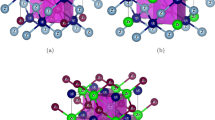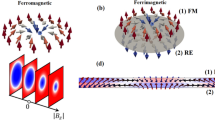Abstract
The thermal evolution of the competition between the ferro-and antiferromagnetic exchange interactions in (Fe0.65Ni0.35)1−x Mnx alloys, which display different magnetic properties, depending on composition and temperature, is investigated. The distribution functions of the magnetic hyperfine fields P(B hf) for 57Fe are determined by Mössbauer spectroscopy in the temperature range 5–300 K for the alloys with x=0, 0.024, 0.082, 0.136, 0.195, and 0.252. The temperature dependence of the integrated intensity I s (T) is analyzed for the low-and high-field portions of P(B hf). The features found in the behavior of I s (T) are interpreted as results of variation of the ratio between the competing exchange interactions of different signs as a result of the thermal destruction of antiferromagnetic Fe-Fe exchange bonds. It is shown that the changes in the spin structure in the low-temperature range are due to the thermal destruction of Fe-Fe exchange bonds. One of the consequences of this destruction is “reentrance” (an increase in the hyperfine field with increasing temperature for some of the Fe atoms). The relationship between the thermal destruction of Fe-Fe exchange bonds and the magnetic transitions of the Fe-Ni-Mn system to the spin-glass state is considered.
Similar content being viewed by others
References
M. Hatherly, K. Hirakawa, D. Lowder, J. F. Mallett, M. W. Stringfellow, and B. N. Torrie, Phys. Solid State 84, 55 (1964).
J. B. Müller and J. Hesse, Z. Phys. B 54, 35 (1987).
M. Shiga, T. Satake, Y. Wada, and Y. Nakamura, J. Magn. Magn. Mater. 51, 123 (1985).
T. Miyazaki, Y. Ando, and M. Takahashi, Phys. Rev. B 34, 6334 (1986).
J. Hesse, C. Böttger, A. Wulfes et al., Phys. Status Solidi A 135, 343 (1993).
C. Böttger, R. Stasch, A. Wulfes, and J. Hesse, J. Magn. Magn. Mater. 99, 280 (1991); M. Fricke and J. Hesse, Hyperfine Interact. 93, 1537 (1994).
B. Huck and J. Hesse, J. Magn. Magn. Mater. 78, 247 (1988).
N. N. Delyagin, G. M. Gurevich, A. L. Erzinkyan, V. P. Parfenova, S. I. Reiman, S. V. Topalov, and M. Trkhlik, Zh. Éksp. Teor. Fiz. 109, 1451 (1996) [JETP 82, 783 (1996)].
W. W. Saslow and G. Parker, Phys. Rev. Lett. 56, 1074 (1986).
B. Huck, F. Sauerbach, and J. Hesse, Hyperfine Interact. 28, 479 (1986).
Author information
Authors and Affiliations
Additional information
Zh. Éksp. Teor. Fiz. 116, 130–140 (July 1999)
Rights and permissions
About this article
Cite this article
Delyagin, N.N., Erzinkyan, A.L., Parfenova, V.P. et al. Thermal destruction of antiferromagnetic Fe-Fe exchange bonds and mechanism of the transition to the spin-glass state in (Fe0.65Ni0.35)1−x Mnx systems with antiferromagnetic competing exchange interactions. J. Exp. Theor. Phys. 89, 70–76 (1999). https://doi.org/10.1134/1.558956
Received:
Issue Date:
DOI: https://doi.org/10.1134/1.558956




